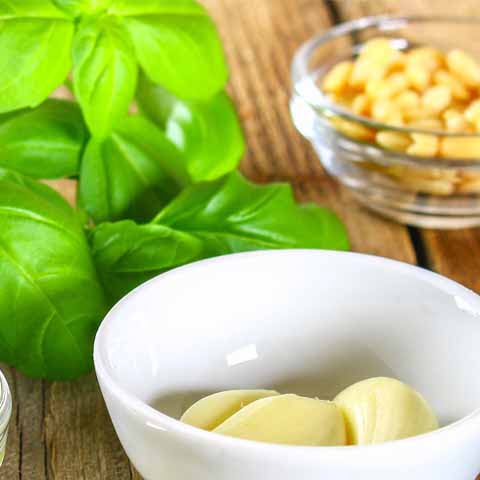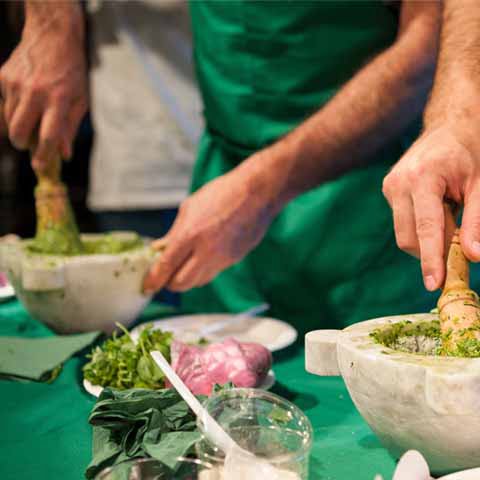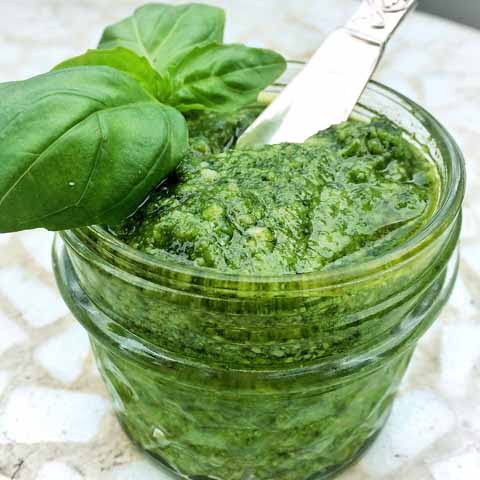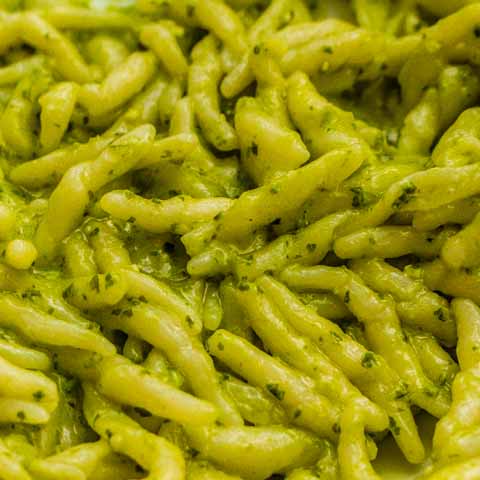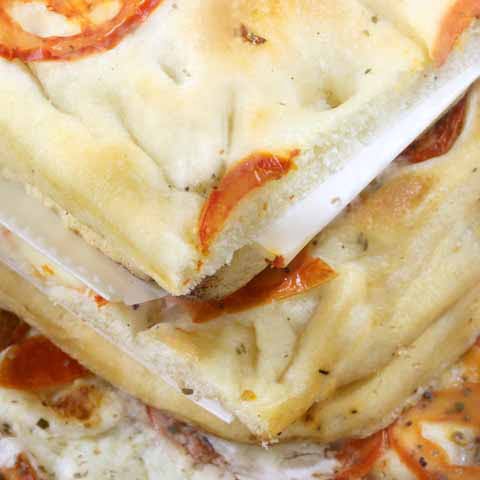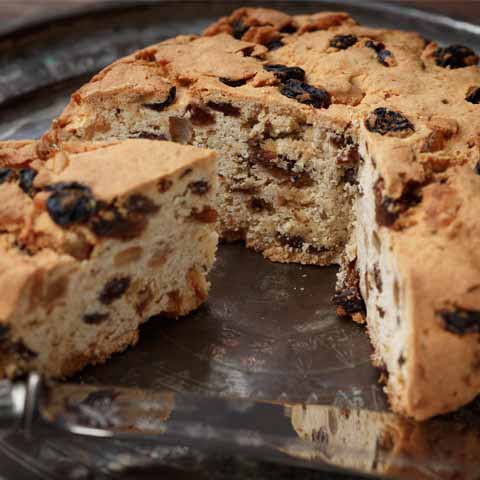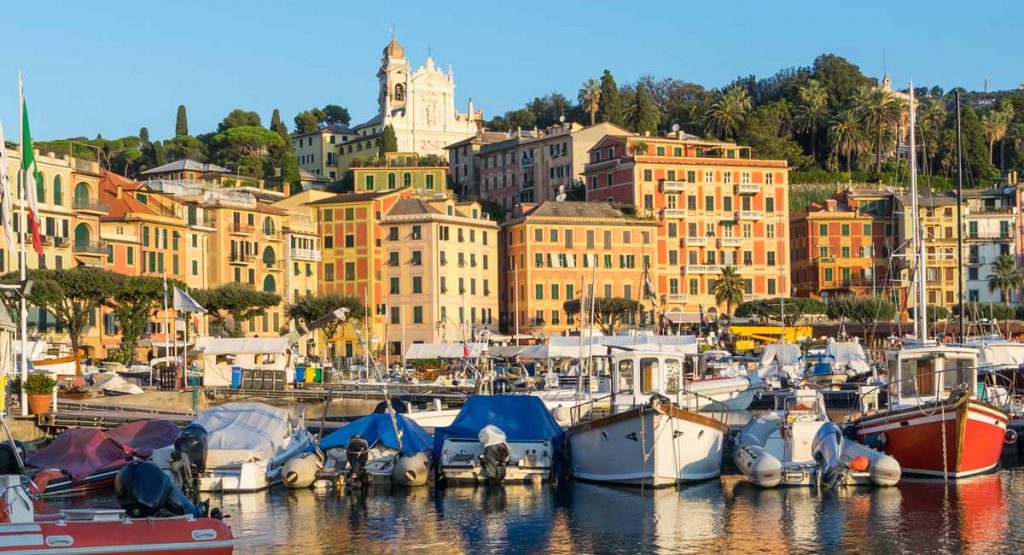The cuisine of Genoa has a common theme of fresh and aromatic products and flavors. While simple and easily accessible, the ingredients have been brought together to create unique and flavorful recipes the region is known for.
Much of the ingenuity behind the traditional dishes is a result of sailors that called what once was the biggest Mediterranean port city their home. These men found themselves out at sea for months on end, living off fish and basic, non-perishable foods. Upon returning to port, they craved anything beyond the bland menu they were confined to at sea. As a result, the fresh vegetables and herbs that were grown in their home soil found their way into many of the traditional Genoese recipes that are still cooked up today.
Favored vegetables included lettuce, zucchini, and eggplant. The tomato was noticeably absent as sailors ate plenty while docked across the pond in America. The fresh herbs on hand included thyme, mint, sweet marjoram, fennel, and basil.
The latter, known as basilico, is considered a sacred plant that has widespread presence in the city’s gastronomy. It is believed that the blend of air from the salty sea and the nearby mountains provides the perfect environment for harvesting the highest quality, aromatic basil in all of Italy. When combined with olive oil, another local staple, this premium basil is the foundation for the pesto sauce that this capital of Northwest Italy’s Liguria region is famous for.
While the sailors of centuries past tired of the region’s seafood, it has naturally found its way into the area’s cuisine. Today, the local cuisine consists of several key staples including herbs (basil in particular), vegetables, extra virgin olive oil, bread and flatbreads, pasta, and a variety of seafood. From anchovies to octopus, the chefs of Genoa are known for their skill and creativity in combining the simple, yet readily available ingredients of the region.
APPETIZERS
Italian meals traditionally start off with a light appetizer and in Genoa, cured meat is a common highlight of this introduction. In particular, thinly sliced Genoese salame paired with cheeses is a local favorite. Common cheeses enjoyed in the area include pecorino, goat cheese, and toma.
While the elaborateness varies depending upon the venue – other options commonly found at the beginning of a meal are stuffed and lightly fried vegetables, stuffed olives, finger sandwiches, and crostini.
However, the most popular local appetizer is, without a doubt, focaccia genovese. Now ubiquitous throughout the Liguria region, this delicious flatbread originated in the city of Genoa. Served as an appetizer, street food, snack, or breakfast, focaccia alla genovese is a delicious flatbread enjoyed by locals and visitors alike. Traditional focaccia genovese is only topped with extra virgin olive oil, however it is possible to find variations topped with other, simple ingredients such as onions, olives, cheese, or herbs.
Farinata, another type of flatbread from the Liguria region, is made using chickpea flour, extra virgin olive oil, salt, and water. It is typically served plain, and like Focaccia, locals may enjoy Farinata as a street food as well.
FIRST COURSE
Following the light starter, the first course in Genoese cuisine frequently consists of a pasta dish, and there are many to choose from. In particular, pansoti, a filled pasta that is similar to ravioli with a rounded shape, but never filled with meat. Traditionally the pasta was filled with wild herbs, while today chard, spinach, and borage are the most popular fillings.
Another local stuffed pasta is known as ravioli alla genovese. Originally from Genoa, these delicious ravioli have spread throughout the Liguria region. As opposed to pansoti, ravioli alla genovese are filled with meat. The most common filling is veal mixed together with leftover organ meat, herbs, and vegetables (such as borage). These delicious morsels are commonly served with tocco, a local sauce made from a single piece of meat. This sauce may also be called ragù alla genovese.
Trofie, another characteristic pasta shape of the Liguria region, are made by twisting a small piece of dough by hand. Additionally, Genoa is known for longer pasta shapes as well, namely bavette and trenette, both of which are similar to linguine.
Corzetti or croxetti are a flat, circular pasta. Once formed, they are stamped utilizing a wooden tool to give them a decorative pattern and extra texture to collect the accompanying sauce.
The variety of sauces offered are as diverse as the pastas available. Favorites include agliata – a garlic sauce, and Salsa di noci – a combination of walnuts, olive oil, garlic, salt, and milk-soaked bread, the latter traditionally tops the pansoti. Ligurian cuisine also features variations of ragù, such as ragù di selvaggina, which is made with wild game (such as boar or hare) and ragù al coniglio (rabbit ragù). Since mushrooms and olives are plentiful in the area, sugo di funghi, or mushroom sauce, as well as sugo con olive, or olive sauce, are both fairly common.
However, the star of the show when it comes to Genoese sauces is sure to be pesto. With locally-grown fresh basil as the foundation, the sauce also contains local olive oil, salt, garlic, pine nuts, pecorino cheese, and parmigiano cheese. It is hand ground to perfection with a mortar and pestle. In Liguria, each family has its own secret ratio for the ingredients. Pesto may be served with any of the local pasta shapes such as trofie and trenette as well as gnocchi. Traditionally, the pesto sauce is tossed with the pasta prior to serving, though in the Liguria region, pasta al pesto may also feature potatoes and green beans that are boiled in water with the pasta. After draining, the pasta, potatoes, and green beans are tossed with the pesto and served.
Pesto is a key ingredient of another Genoese staple, that is lasagne al pesto. This layered pasta dish features pesto, bechamel and parmigiano cheese. In some cases, potatoes and green beans may be added.
One of the local soups, minestrone alla genovese, is an adaption of Italy’s classic minestrone. The key ingredients in Genoa’s version include zucchini, borage, potatoes, beans, pasta or rice, and pesto, which provides a unique infusion of flavor.
In addition to pastas and soups, locals may also enjoy a risotto featuring fresh ingredients. Common pairings include risotto with borage, artichokes, mixed seafood, mushrooms or trumpet flowers.
Savory pies and tarts comprise another category of first course dishes favored by the locals. The prime example is torta verde, which consists of a thin dough stuffed with green vegetables, such as chard or zucchini, as well as cheese. The dish is easily adaptable, and many local families have their own special recipes. Depending on the portion size, torta verde may also be served as an appetizer.
SECOND COURSE
Meat makes its appearance during the second course in most of Italian cuisine, and this is the case in Genoa as well, in addition to the local seafood.
One of Genoa’s most characteristic meat dishes is cima alla genovese. The dish is made by stuffing veal stomach with veal meat, offal, eggs, garlic, pine nuts, parmigiano cheese, marjoram, and herbs. After sewing the stomach closed, it is boiled very carefully. Once considered to be a dish of the poorer classes due to its ingredients, today the dish is a highly-regarded specialty of Genoese cuisine.
Several other meat-based regional dishes include angello arrosto (roast lamb), capra e fagioli (goat and beans), rostelle (meat skewers), cinghiale alla ligure con polenta (braised wild boar with olives, pine nuts, and polenta), and coniglio alla ligure (braised rabbit with olives and pine nuts).
In Genoa, land to raise pasture animals is not as widely available as other regions of Italy; thus, this course features much of the local seafood. Soups are popular locally, including stoccafisso stew made with stockfish, tomatoes, potatoes, raisins, pine nuts, and olive oil – and ciuppin, a soup which originated at sea to make use out of the unsellable fish, which features a variety of seafood, including leftovers, cooked with mushrooms, tomatoes, white wine, onions, garlic, carrots, and celery. The dish is usually topped with parsley and served with slices of toasted or grilled bread for dipping.
Whether fried, baked, boiled or served raw, there are many types of seafood to be tasted including garfish, tuna, swordfish, anchovies, sardines and mussels.
Anchovies are typically salted, though they can also be used to make bagnun, a soup consisting of fresh anchovies, onions, tomatoes, and extra virgin olive oil. Both anchovies and sardines may be served stuffed with a mixture of seasonal ingredients, such as spinach or chard, as well as parmigiano cheese, bread, and garlic.
Cappon magro is an elaborate recipe that has been made in Liguria for centuries. Due to its long ingredient list and preparation time, cappon magro is typically reserved for religious holidays, such as Easter. Originally invented by local fishermen as a way of utilizing leftover fish. The dish can be best described as a seafood and vegetable salad in which the ingredients are arranged on hardtack. A wide variety of seafood may be used such as lobster, clams, shrimp, and other shellfish. Cappon magro is typically served with salsa verde, a green sauce consisting of parsley, bread, garlic, capers, pine nuts, olives, eggs, salted anchovies, olive oil, vinegar, and salt. Salsa verde is a staple of Ligurian cuisine and may be served with other seafood or meat dishes as well.
A local dish that combines seafood with land ingredients is known as seppie in zimino. The dish consists of cuttlefish cooked with chard, tomatoes, onion, celery, and carrots. Locals serve the cuttlefish and vegetables on small pieces of toasted bread (crostini) and with a nice glass of wine.
SIDES & CONDIMENTS
Meals in this Ligurian city are not complete without a complementary side or two, and of course condiments to further enhance the flavors. Vegetables are frequent side dishes in genoese cuisine. This may include roasted cardoons, baked zucchini, and baked artichokes.
Sauces can truly make a meal complete when dining in Genoa. From the famed pesto to a traditional meat or garlic sauce – they can take any dish to another level. Salsa di pinoli is a perfect blend of garlic, pine nuts, extra virgin olive oil, bread, cheese, and marjoram.
STREET FOOD
Like many Italian cities, Genoa has its own take on street food. While tours focused on this specialty are available, visitors can sample a variety of quick and convenient foods while exploring the many alleyways that wind their way through town. With the diverse selection of venues, various small snacks and other take-away foods can be enjoyed at a small corner table or on-the-go.
The friggitorie sell local fried favorites such as fried calamari, batter balls called friscieu that are stuffed with fish and herbs, and vegetable tortes. A favorite is the torta Pasquialina, made of phyllo dough and stuffed with artichokes, swiss chard, zucchini, herbs, cheese, and egg. Another favorite fried treat, farinata, is an unleavened pancake consisting of chickpea flour, water, olive oil, and salt.
Be sure to stop by a bakery to try fresh baked goods, namely Genoa’s own original focaccia flatbread, which is best enjoyed piping hot straight out of the oven and topped with only olive oil and salt.
DESSERT
To properly end a meal in this region, there are a number of desserts that will not disappoint. The most popular sweet is Pandolce, or “sweet bread.” Considered a Christmas bread, pandolce contains raisins, pine nuts, and candied fruit. It is made in basso (low) or alto (high) versions. The basso was created to be long-lasting and appropriate for long excursions at sea, whereas the alto fruitcake is leavened and contains a tasty sourdough. Those made to be more elaborate may be topped with candied orange peel or Diamante citron and a dash of fennel seeds.
Other common additions to the dessert tray include latte dolce fritto – a deep fried custard with a light sprinkling of powdered sugar, panera – a blend of semifreddo and coffee gelato, canestrelli – shortbread cookies, gobeletti – tartlets with a fruit jam filling, and biscotti del Lagaccio – twice baked cookies flavored with fennel seeds.
WINE IN GENOA
Set between the Alps and the Appenine mountain ranges, the rocky terrain of Genoa is not ideal for extensive vineyards, resulting in minimal wine production around the city. However, its central location within Liguria ensures the residents and visitors will never do without. There are fine wines produced throughout the surrounding region to be enjoyed.
The western parts and eastern parts of Liguria (Riviera of Ponente and Riviera of Levante, respectively) are home to many unique and striking whites and reds that have been recognized with the Designation of Controlled Origin (DOC) label. One excellent example is Vermentino, which is a dry white wine with fruity aromas that may be produced in the area surrounding Genoa as well as the provinces of Imperia and Savona.
The nearby Tigullio Gulf, which is part of the metropolitan city of Genoa, produces a number of excellent DOC wines including Bianco Tigullio, Ciliegiolo del Tigullio, Rosso del Tigullio, and Spumante del Tigullio.
Other Ligurian wines that visitors should try include the following: Cinque Terre’s Sciacchetrà, Rossese di Dolceacqua, Pigato, and Colline di Levanto novello.
Due to its location between the mountains and sea, Genoa’s cuisine features an astounding variety of high-quality ingredients. From delicious pesto and golden focaccia genovese to canestrelli and Vermentino, mealtime in Genoa is a true delight.
Don't just see Italy, live it.
Your dream trip to Italy has never been closer
No more endlessly scrolling travel sites. Our travel experts will craft the perfect, one-of-a-kind trip just for you.

300+
DESTINATIONS
We offer more Italian destinations than any travel site. Do and see more with Trips 2 Italy.
1 (of a kind)
ITINERARIES
Because your dream trip to Italy should be designed for you, not for the masses.
100%
PEACE OF MIND
From flights and accommodations, to food and activities - we take care of every detail.
